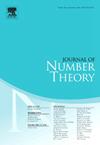Fields generated by points on superelliptic curves
IF 0.7
3区 数学
Q3 MATHEMATICS
引用次数: 0
Abstract
We give an asymptotic lower bound on the number of field extensions generated by algebraic points on superelliptic curves over with fixed degree n and discriminant bounded by X. For C a fixed such curve given by an affine equation where and , we find that for all degrees n divisible by and sufficiently large, the number of such fields is asymptotically bounded below by , where as . We then give geometric heuristics suggesting that for n not divisible by , degree n points may be less abundant than those for which n is divisible by and provide an example of conditions under which a curve is known to have finitely many points of certain degrees.
由超椭圆曲线上的点生成的场
对于由仿射方程ym=f(x)给出且m≥2且d=deg (f(x)≥m的固定曲线C,我们发现对于所有能被gcd (m,d)整除且足够大的n次,此类场的个数在下渐近有x δn的下界,其中δn→1/m2 = n→∞。然后,我们给出几何启发式,表明对于n不能被gcd (m,d)整除的情况,n次点可能比n能被gcd (m,d)整除的情况少,并提供了已知曲线具有有限多个特定度点的条件示例。
本文章由计算机程序翻译,如有差异,请以英文原文为准。
求助全文
约1分钟内获得全文
求助全文
来源期刊

Journal of Number Theory
数学-数学
CiteScore
1.30
自引率
14.30%
发文量
122
审稿时长
16 weeks
期刊介绍:
The Journal of Number Theory (JNT) features selected research articles that represent the broad spectrum of interest in contemporary number theory and allied areas. A valuable resource for mathematicians, the journal provides an international forum for the publication of original research in this field.
The Journal of Number Theory is encouraging submissions of quality, long articles where most or all of the technical details are included. The journal now considers and welcomes also papers in Computational Number Theory.
Starting in May 2019, JNT will have a new format with 3 sections:
JNT Prime targets (possibly very long with complete proofs) high impact papers. Articles published in this section will be granted 1 year promotional open access.
JNT General Section is for shorter papers. We particularly encourage submission from junior researchers. Every attempt will be made to expedite the review process for such submissions.
Computational JNT . This section aims to provide a forum to disseminate contributions which make significant use of computer calculations to derive novel number theoretic results. There will be an online repository where supplementary codes and data can be stored.
 求助内容:
求助内容: 应助结果提醒方式:
应助结果提醒方式:


